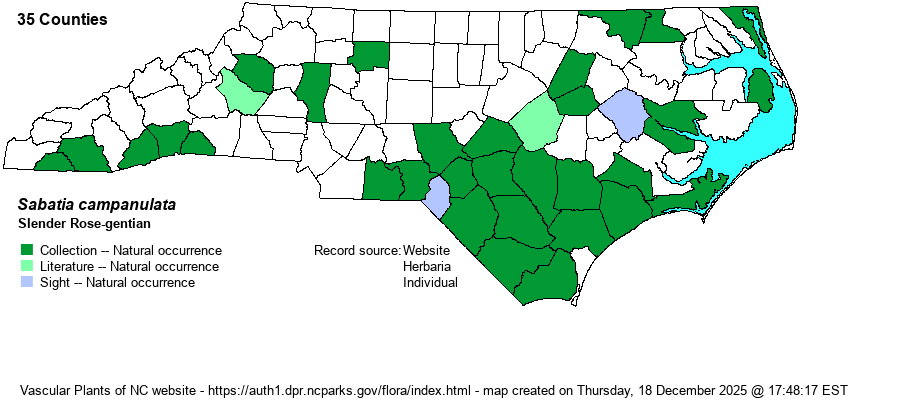| Author | (L.) Torrey | |
| Distribution | Scattered over nearly all of the Coastal Plain, though primarily found in the southern 40%, in the Longleaf Pine (Pinus palustris) zones. Present at scattered places in the Piedmont and southern Mountains, but generally scarce west of the Coastal Plain.
This is a Southeastern species with a scattered range, numerous only in the Coastal Plain. It ranges north to MA, NY, and IN south to northern FL and eastern TX.
| |
| Abundance | Uncommon to infrequent in the southern Coastal Plain, but can be locally numerous in well-managed pinelands with prescribed burns. Very rare to rare elsewhere in the Coastal Plain, and extremely rare westward to the southern Mountains. | |
| Habitat | This is a wetland species, generally of sunny, grassy/sedgy places. It grows mostly in pine savannas, but it is also present in wet spots in powerline clearings (that mimic savannas), sandhill or pocosin seepages, and in bogs. | |
| Phenology | Blooms from June to August, and fruits from September to October. | |
| Identification | This is most slender of the state's Sabatia species, growing erect to somewhat leaning, to about 2 feet tall, with a few branches in the upper portions. However, it has very slender opposite leaves, they being linear, about 1-2 inches long and barely 1/8-inch wide. At the ends of the branches grow the bright rose-pink flowers, with the standard yellow bases and red ring between the yellow and pink. Each flower has 5 petals and averages 1-inch across, and thus the species has quite attractive flowers; however, it is the narrow, needle-like leaves that set this species apart from all others. S. stellaris is essentially limited to tidal marshes and tidal flats, and it has wider leaves that are lanceolate; also, it has shorter sepals than does S. campanulata, which has sepals about as long as the petals. To see this species, you should visit coastal managed pinelands and walk through some savannas in midsummer. You might also see S. gentianoides, an even more spectacular species, in the same savanna on the same visit. | |
| Taxonomic Comments | None
| |
| Other Common Name(s) | Slender Marsh-pink | |
| State Rank | S3 | |
| Global Rank | G5 | |
| State Status | | |
| US Status | | |
| USACE-agcp | FACW link |
| USACE-emp | FACW link |

